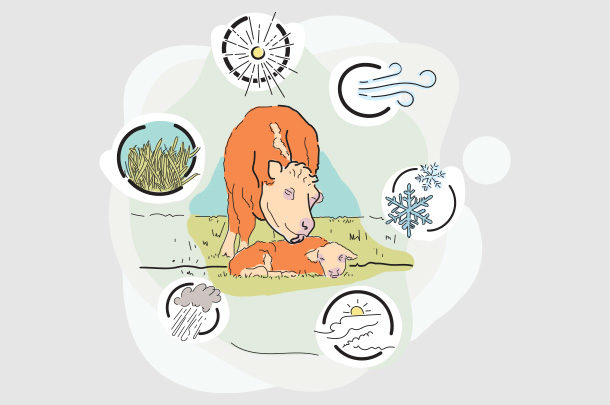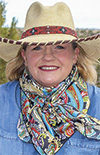It’s that time of year again. Young calves on the ground, ranchers exhausted, wondering how they ever got through calving season in harsh winter weather. Checking heifers in the middle of the night. Maybe even shifting feeding times to hopefully encourage daytime births. Folks are tired; tempers are short. It is a tough time of year.
And the social media posts. Tiny calves in snow. A cow lying down in the snow and ice, giving birth, and the heroic ranchers “saving” the calf. This scenario is fairly commonplace across the West and beyond in February and March. April finds ranchers grateful they survived another brutal calving season and welcoming spring and green grass.
I’m going to play devil’s advocate here for a moment. Hear me out. Is it time to rethink the timing of calving on your ranch? Can some of this headache and heartache be avoided? Is this the picture we want to portray to the public? Sure, it is a good idea to save those calves. But what if we never put that cow in that position in the first place?
Remember those ads on TV for a certain brand of margarine? “It’s not nice to fool Mother Nature!” Are we trying to “fool Mother Nature” and force calving when it is not an optimum time?
Why do we calve in February or March in states where weather is routinely an issue? To have bigger weaning weights for October delivery of calves? What if, just what if, we calved later – more in sync with Mother Nature?
“My weaning weights would be low.” “I need bigger calves to make money.”
Or one of my favorites: “That’s how we have always done it.” And, of course, my perennial favorite: “That won’t work here.”
Is your goal to have the biggest weaning weights to tell the neighbors about at the café in town or over coffee at the elevator? Realize you are comparing gross revenue, not net profit. What did it take to get those weaning weights? Supplemental feed through the winter? Wear and tear on humans, equipment trying to successfully get calves on the ground during blizzards, ice storms? What about death loss of calves, even cows? Is your breedback successful enough when the cows calve in the harsh weather? Failing to get most of them bred the first cycle results in a calf crop that is not particularly uniform when the buyer comes calling.
Using forage to your advantage
What if your greatest animal nutritional demand matched when your forage was highest-quality? Hang with me here. A cow’s greatest nutritional needs are just after calving and as she is in late stages of gestation. Lactating, raising that calf and being able to breed back are the most demanding times on the cow in terms of her nutritional needs. We are asking her to do that in the harshest weather of the year.
When is your forage at the most nutritious? I would argue that for most cattlemen, it is not February or March. I am speaking primarily about native grass and rangeland. In the semiarid West, where late winter and early spring calving is widely practiced, the forage base is at its least nutritious at that time. Which we typically make up for with aggressive feeding and supplementation. Extra labor costs.
So your rangeland peaks in nutrition sometime late spring and early summer. Many areas get a “bump” in the fall before dormancy as well. What if you timed your calving to match the nutritional value peaks of the forage? What if, just what if, your goal was not the biggest calves in your country? But you just might have the best net profits? And that is the name of the game here, right?
Collaborate with Mother Nature, not treat her like a prizefighter you challenge annually, and maybe you (and your bank account) will emerge with less bruises from the battle. If left to natural cycles, animals do not have their young when there is no forage of any value and conditions are at their absolute worst. I submit that Mother Nature might be a better stockman than a lot of us.
Gross income versus net profit
Let’s talk about income from those calves at weaning. Data from the Big Horn Classic Sale in Sheridan, Wyoming, from August 2021 for the region including Montana, Wyoming, Utah, Colorado, Nebraska and the Dakotas for October delivery show a 420-pound steer brought an average of $209.20 per hundredweight (cwt) for a total of $878.64. A 570-pound steer sold for an average of $188 per cwt, a total of $1,071.60. The guy with the 620-pound calves sold his for an average of $178.50 per cwt for a total of $1,106.70. That’s a $228.06 difference between a light steer and one with another 200 pounds. Seems pretty significant.
But what did it take to get that $228.06 in your pocket? Gross revenue from your calves is only a tiny part of the story. What did you spend to get there? Supplemental feed? More round bales? Cake feeder on your truck? Overhead cake bin at the ranch? Tractor? Extra labor during calving season? More repairs on your pickup, a new battery in cold weather? Could you have brought more calves to the marketplace if the winter storm had not claimed several of them? Maybe you’d have had more pregnant cows if they’d been bred in optimal conditions? A more uniform calf crop? To compare, you must figure in breedback and death loss as costs as well.
Perhaps it might be useful during one of these winter storms to sit down, sharpen your pencil and decide if it is worthwhile to calve in the winter.
Get to know your forage resource. When is it optimum? Are you trying to fool Mother Nature? She can be a valued business partner or a formidable adversary. As I always say, if ranching was easy, they’d call it “rocket science.”










